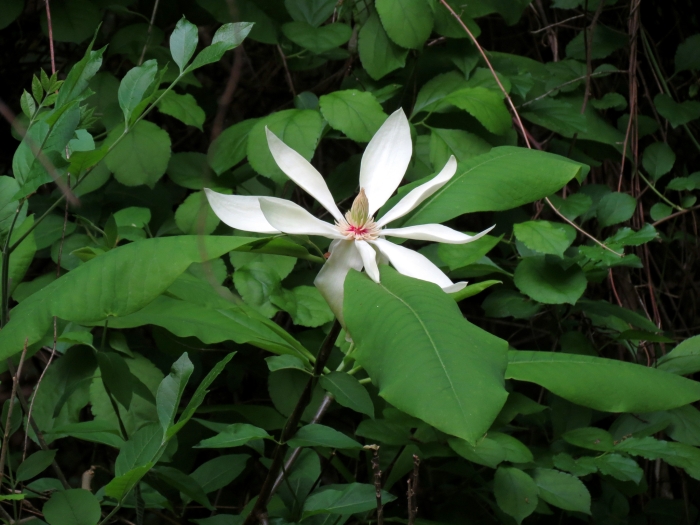Umbrella Magnolia
(Magnolia tripetala)
Umbrella Magnolia (Magnolia tripetala)
/
/

Katja Schulz
CC BY 4.0
Image By:
Katja Schulz
Recorded By:
Copyright:
CC BY 4.0
Copyright Notice:
Photo by: Katja Schulz | License Type: CC BY 4.0 | License URL: http://creativecommons.org/licenses/by/4.0/ | Rights Holder: Katja Schulz | Publisher: iNaturalist | Date Created: 2017-04-30T17:51:14-07:00 |

























































Estimated Native Range
Summary
Magnolia tripetala, commonly known as Umbrella Magnolia, is a deciduous tree native to the understory of rich, moist forests and stream banks in the Eastern and Central United States. It can reach up to 49 feet (15 meters) in height and is known for its large, showy, spring-blooming flowers. The flowers are large, spanning 6-10 inches (15-25 cm) in diameter, with six to nine creamy-white tepals and a prominent red style, which matures into a striking red fruit (an aril) about 4 inches (10 cm) long containing several seeds. The leaves of the Umbrella Magnolia are uniquely whorled at the ends of the branches, resembling an umbrella, and can turn a clear yellow in the fall.
The Umbrella Magnolia is valued for its ease of cultivation, distinctive large leaves, and the architectural form it adds to the landscape. It is often used as a specimen tree in residential gardens and can be an intriguing addition to native plant gardens. While it is shade-tolerant, it thrives in full sun to part shade and prefers moist, well-drained soils. The shallow, spreading roots necessitate careful consideration when planting near sidewalks or foundations. Pollination by beetles is an interesting ecological aspect, as the flowers have evolved to attract these specific pollinators. Potential problems include leaf spots and canker diseases, but these are generally not severe.CC BY-SA 4.0
The Umbrella Magnolia is valued for its ease of cultivation, distinctive large leaves, and the architectural form it adds to the landscape. It is often used as a specimen tree in residential gardens and can be an intriguing addition to native plant gardens. While it is shade-tolerant, it thrives in full sun to part shade and prefers moist, well-drained soils. The shallow, spreading roots necessitate careful consideration when planting near sidewalks or foundations. Pollination by beetles is an interesting ecological aspect, as the flowers have evolved to attract these specific pollinators. Potential problems include leaf spots and canker diseases, but these are generally not severe.CC BY-SA 4.0
Plant Description
- Plant Type: Tree
- Height: 30-45 feet
- Width: 15-30 feet
- Growth Rate: Moderate
- Flower Color: Cream, White
- Flowering Season: Spring
- Leaf Retention: Deciduous
Growth Requirements
- Sun: Full Sun, Part Shade
- Water: Medium
- Drainage: Medium, Slow
Common Uses
Bee Garden, Bird Garden, Butterfly Garden, Deer Resistant, Showy Flowers
Natural Habitat
Understory of rich, moist forests and stream banks in the Eastern and Central United States
Other Names
Common Names: Umbrella-Tree , Paraplymagnolia
Scientific Names: Magnolia tripetala , Magnolia umbrella , Houpoea tripetala , Kobus tripetala , Magnolia frondosa , Magnolia michauxii , Magnolia umbellata , Magnolia umbrella var. tripetala , Magnolia virginiana var. tripetala
GBIF Accepted Name: Magnolia tripetala (L.) L.